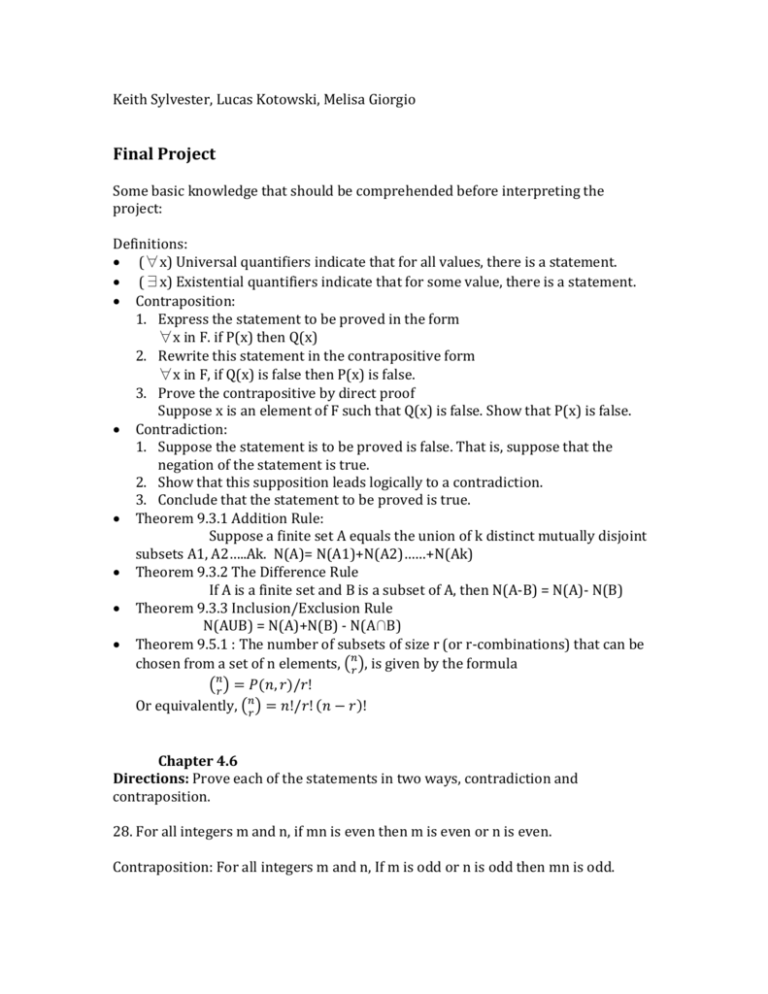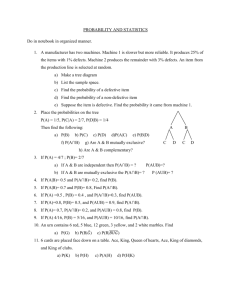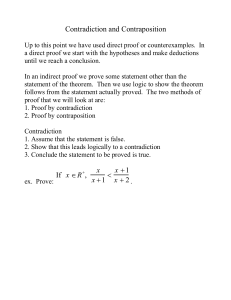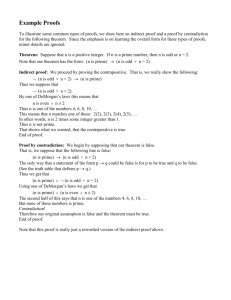Project2 - WordPress.com
advertisement

Keith Sylvester, Lucas Kotowski, Melisa Giorgio Final Project Some basic knowledge that should be comprehended before interpreting the project: Definitions: (∀x) Universal quantifiers indicate that for all values, there is a statement. (∃x) Existential quantifiers indicate that for some value, there is a statement. Contraposition: 1. Express the statement to be proved in the form ∀x in F. if P(x) then Q(x) 2. Rewrite this statement in the contrapositive form ∀x in F, if Q(x) is false then P(x) is false. 3. Prove the contrapositive by direct proof Suppose x is an element of F such that Q(x) is false. Show that P(x) is false. Contradiction: 1. Suppose the statement is to be proved is false. That is, suppose that the negation of the statement is true. 2. Show that this supposition leads logically to a contradiction. 3. Conclude that the statement to be proved is true. Theorem 9.3.1 Addition Rule: Suppose a finite set A equals the union of k distinct mutually disjoint subsets A1, A2…..Ak. N(A)= N(A1)+N(A2)……+N(Ak) Theorem 9.3.2 The Difference Rule If A is a finite set and B is a subset of A, then N(A-B) = N(A)- N(B) Theorem 9.3.3 Inclusion/Exclusion Rule N(AUB) = N(A)+N(B) - N(A∩B) Theorem 9.5.1 : The number of subsets of size r (or r-combinations) that can be chosen from a set of n elements, (𝑛𝑟), is given by the formula (𝑛𝑟) = 𝑃(𝑛, 𝑟)/𝑟! Or equivalently, (𝑛𝑟) = 𝑛!/𝑟! (𝑛 − 𝑟)! Chapter 4.6 Directions: Prove each of the statements in two ways, contradiction and contraposition. 28. For all integers m and n, if mn is even then m is even or n is even. Contraposition: For all integers m and n, If m is odd or n is odd then mn is odd. Let m=2x+1 (by def. of odd) Let n=2y (representing any integer) Mn=(2x+1)(2y) =4xy+2y =2(2xy+y) (even by def.) Hence mn is even, giving the contraposition is false. Contradiction: There exists an integer for m and n, mn is even and m is odd or n is odd. Let m=2k+1(odd by def of odd) Let n=2x (any integer) Mn= (2k+1)(2x) =4kx+2x =2(2kx+x) (by def of even) Hence this contradiction is true, meaning the given statement is false. Chapter 9.3 18. Just as the difference rule gives rise to a formula for the probability of the compliment of an event, so the addition and inclusion/exclusion rules give rise to formulas for the probability of the union of mutually disjoint events and for a general union of (not necessarily mutually exclusive) events. a. Prove that for mutually disjoint events A and B, P(AUB)=P(A) +P(B). Proof: A and B are in the space T and are disjoint events. Using the equally likely probability formula. P(AUB)= X(AUB)/X(T) =X(A)+X(B)/X(T) =(X(A)/X(T)) + (X(B)/X(T)) =P(A)+ P(B) b. Prove that for any events A and B. P(AUB) = P(A)+P(B) - P(A∩B) Proof: If P(A) and P(B) are added then the elements that contain in both are accounted for two times. Therefore subtracting P(A∩B) to get an accurate calculation of A and B. Chapter 9.5 22. Each symbol in the Braille code is represented by a rectangular arrangement of six dots, each of which may be raised or flat against a smooth background. Given that at least one of the six dots must be raised, how many symbols can be represented in the Braille code? The answer can be found by adding the total number of arrangement with the total number of arrangements with one dot raised to all dots raised. (61) + (62) + (63) + (64) + (65) + (66) Giving us this as our answer. Chapter 10.3 7. Suppose that for all positive integers i, all the entries in the ith row and the ith column of the adjacency matrix of a graph are 0. What can you conclude about the graph? That the graph will be symmetric in size and walks. 19. a) Let A = [1 1 2] Find A^2 and A^3 [1 0 1] [2 1 0] A^2 = [1 1 2] [1 1 2] [6 3 3] [1 0 1] [1 0 1] = [3 2 2] [2 1 0] [2 1 0] [3 2 5] A^3 = [1 1 2] [6 3 3] [15 9 15] [1 0 1] [3 2 2] = [9 5 8] [2 1 0] [3 2 5] [15 8 8] b) a^2 has 3 length 2 and 4 length 3 walks








